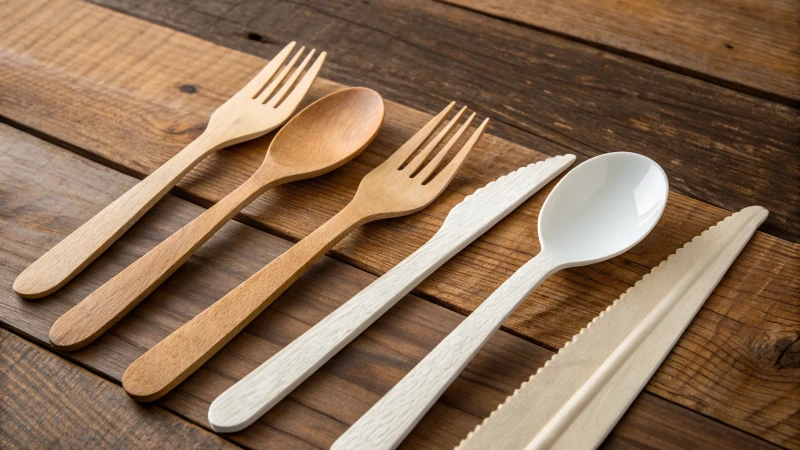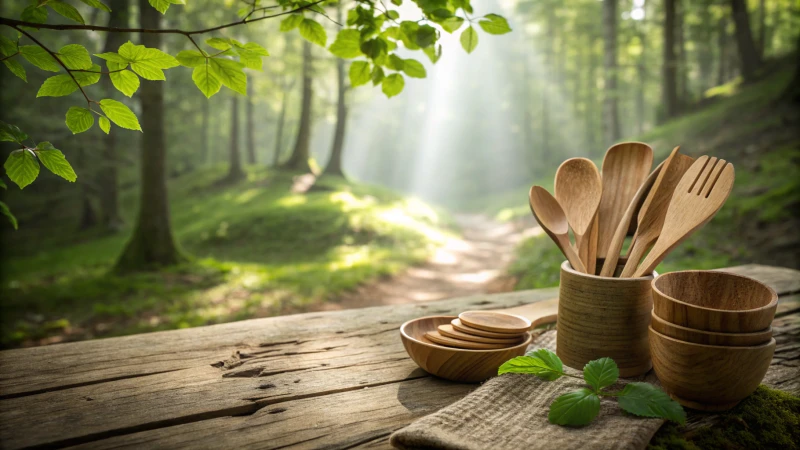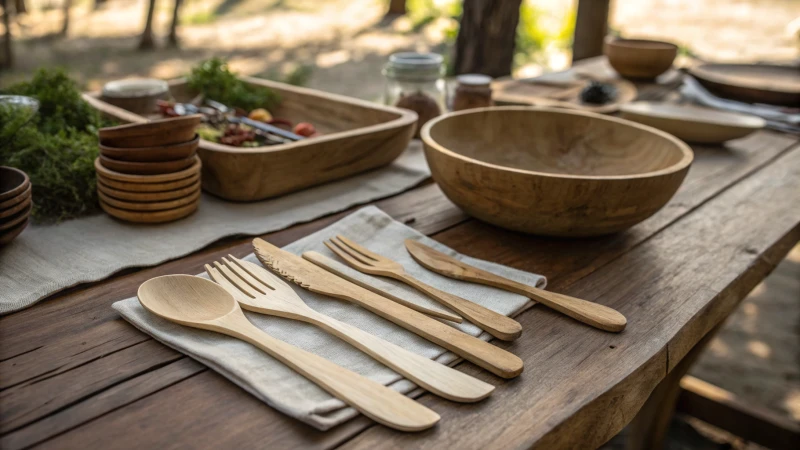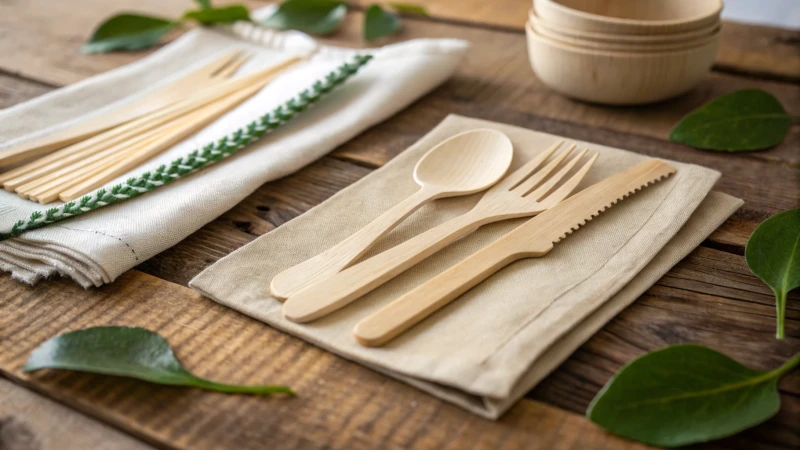
Ever wondered about the real cost behind those eco-friendly wooden forks and knives?
While wooden cutlery often gets the green light for sustainability, its production energy costs can actually be higher than those of plastic or paper alternatives due to the intensive processing required. This can affect its overall environmental footprint, making it less straightforwardly sustainable than it seems.
I remember when I first started diving into sustainability, I was all for wooden everything. It just felt right, you know? But as I learned more, I realized that while wooden cutlery looks and feels like a better choice, the energy used in its production can be surprisingly high. It's not just about chopping down trees; it's the processing, shaping, and even the transportation that rack up the energy costs. This knowledge made me rethink how I define sustainability in my choices.
Wooden cutlery uses more energy to produce than plastic.True
Processing raw wood requires more energy than manufacturing plastic.
Paper cutlery has a higher energy footprint than wooden.False
Paper production is generally less energy-intensive than processing wood.
How does wooden cutlery production impact the environment?
Imagine sitting at a cozy café, sipping your favorite brew, and pondering the environmental impact of the wooden spoon in your hand.
Wooden cutlery production affects the environment mainly through energy use, deforestation, and waste management. To reduce these impacts, it's crucial to employ sustainable practices, such as sourcing certified wood and using eco-friendly manufacturing techniques.

I remember the first time I swapped out my plastic cutlery for wooden ones. It felt like a small but significant step toward a more sustainable lifestyle. However, understanding the real impact of these choices is essential, especially when it comes to wooden cutlery.
Environmental Impact Factors of Wooden Cutlery Production
Energy Consumption
Did you know that producing wooden cutlery usually takes more energy than making paper or plastic utensils1? This is mainly due to the processes involved in cutting, shaping, and finishing the wood. Yet, with technology on our side, we're seeing exciting advancements in machinery efficiency and renewable energy use that are helping lower this energy demand.
Deforestation Concerns
When I think about the wood used for cutlery, deforestation is a concern that comes to mind. Unchecked logging can devastate ecosystems and ramp up carbon emissions. Choosing FSC-certified wood2 is one way to ensure that wood is sourced responsibly, supporting forests that are managed with care for environmental, social, and economic health.
| Type of Certification | Benefits |
|---|---|
| FSC | Ensures responsible forest management |
| PEFC | Promotes sustainable forest management |
Waste Management
One of the best parts about wooden cutlery is its ability to decompose. Unlike plastic, it doesn't linger around for centuries. Still, proper disposal is crucial. By promoting composting and efficient waste management systems, we can maximize the environmental benefits of using wooden utensils.
Carbon Footprint
While wooden cutlery typically has a smaller carbon footprint than plastic, transportation and production emissions still play a role. By prioritizing local sourcing and optimizing supply chains, we can further shrink this footprint.
Comparing Alternatives
When weighing wooden cutlery against other materials, consider aspects like biodegradability, resource consumption, and waste production. Bamboo cutlery shares a similar eco-friendly profile but grows faster than most hardwoods.
| Material | Biodegradability | Resource Consumption |
|---|---|---|
| Wood | High | Moderate |
| Bamboo | High | Low |
| Plastic | Low | High |
By understanding these factors, I can make smarter decisions about integrating wooden cutlery into my sustainable lifestyle and encourage others to do the same.
Wooden cutlery requires more energy than plastic to produce.True
Wooden cutlery production uses more energy for cutting and shaping processes.
FSC-certified wood does not contribute to deforestation.True
FSC certification ensures wood is sourced from responsibly managed forests.
Why Choose Wooden Cutlery Despite Higher Energy Costs?
Ever wondered why people choose wooden cutlery despite its higher production costs? Let’s dive into the surprising benefits that make it worth the investment.
Wooden cutlery, though more energy-intensive to produce, is biodegradable, reduces plastic waste, and offers a charming natural aesthetic. These benefits not only support sustainability but also enhance brand image and customer loyalty.

Environmental Benefits of Wooden Cutlery
I remember the first time I held a piece of wooden cutlery at a family picnic. It felt different—more connected to nature. I didn't realize then that by choosing wooden over plastic, I was part of a bigger movement. Wooden cutlery biodegrades naturally, unlike plastic, which can haunt our planet for centuries. For anyone like me, trying to be more eco-conscious, knowing my forks and knives won't end up in a landfill forever is a comforting thought.
| Benefit | Description |
|---|---|
| Biodegradability | Decomposes naturally, reducing landfill waste |
| Carbon Footprint | Production can be offset with sustainable practices |
Aesthetic and Branding Advantages
Have you ever been to a chic café and noticed how the little details like cutlery can elevate the whole experience? That's the magic of wooden utensils. They lend a rustic, natural charm that not only looks good but feels good too. For businesses, this can be crucial. I've seen eco-friendly cafes gain a loyal customer base just because they align their aesthetic with sustainable values. It's not just about the look—it's about making a statement.
Consider how businesses like high-end restaurants3 or eco-friendly cafes benefit from such an image. The ability to customize these items further enhances their appeal.
Supporting Sustainable Practices
Yes, producing wooden cutlery requires more energy. But think about the entire lifecycle. From sustainably harvested wood to energy-efficient production techniques, there's a commitment to doing better for our planet. I've learned that working with responsible suppliers can help mitigate some of those energy costs.
| Strategy | Description |
|---|---|
| Sourcing | Using sustainably harvested wood |
| Technology | Employing energy-efficient manufacturing processes |
Finding the right supplier is key. Companies like WonBon focus on transparency and quality, ensuring their products meet high environmental standards4. Sure, wooden cutlery might come with initial hurdles in terms of energy costs, but prioritizing long-term environmental benefits aligns with global sustainability trends. And for those of us committed to a greener future, that's a trade-off worth making.
Wooden cutlery is biodegradable and decomposes naturally.True
Wooden cutlery decomposes unlike plastic, reducing landfill waste.
Plastic cutlery has a lower carbon footprint than wooden cutlery.False
Plastic takes centuries to decompose, increasing its environmental impact.
How Does Cutlery Manufacturing Affect Energy Use?
Ever wondered how your favorite cutlery is made and the energy it consumes? Dive into the fascinating world of cutlery production and its environmental impacts.
Production methods significantly impact energy consumption in cutlery manufacturing. Wooden cutlery often requires more energy due to processing and treatment, whereas plastic cutlery, although less energy-intensive initially, has higher environmental costs.

Examining the Production of Wooden Cutlery
Imagine walking through a lush forest, feeling the connection to nature that wooden cutlery can bring to our tables. However, behind this natural charm lies a complex production process that can be quite energy-intensive. I remember visiting a small family-owned factory that specialized in wooden cutlery. The warmth of the kiln was overwhelming as I learned about the energy required to dry the wood thoroughly—an essential step to prevent warping or cracking. This drying process, known as kiln drying, significantly increases energy consumption.
Furthermore, ensuring that the cutlery is safe and durable for food use involves additional treatments. I watched as artisans applied biodegradable varnishes, each brush stroke consuming more energy but adding to the quality and safety of the final product. These efforts, while increasing the carbon footprint5, also ensure that wooden cutlery can return to the earth more gracefully once its job is done.
Plastic Cutlery: Energy and Environmental Considerations
Plastic cutlery, on the other hand, takes me back to my college days when every event seemed to feature those ubiquitous white plastic forks. Produced by melting and molding polymers, plastic cutlery might seem less demanding at first. The molding processes, like injection molding, are quick and efficient, yet they still consume a fair amount of energy.
The real environmental challenge with plastic lies in its afterlife. Despite the relatively moderate energy use during production, I often think about the countless pieces of plastic that end up in landfills because they're tough to recycle due to contamination. This stark reality underscores why many consider plastic less sustainable in the long run.
| Material | Energy Usage | Environmental Impact |
|---|---|---|
| Wood | High | Low (biodegradable) |
| Plastic | Moderate | High (non-biodegradable) |
Metal Cutlery: Durable but Energy-Intensive
When I think of metal cutlery, I recall the polished silverware passed down through generations in my family. Metal cutlery’s durability is unmatched, yet creating these enduring pieces is anything but energy-efficient. The process involves extraction and refining of metals like stainless steel—steps that require substantial electricity and fuel.
Visiting a modern manufacturing plant revealed how much energy goes into forming and finishing metal cutlery. Watching molten metal being forged into shape and meticulously polished was a reminder of the energy investment needed for such durability. Despite the initial high energy cost, metal cutlery's long lifespan can contribute positively to a circular economy6.
Innovations in Cutlery Manufacturing
Innovation is at the heart of reducing environmental impact. During my travels, I've seen firsthand how factories are embracing change by adopting efficient machinery designed to minimize energy waste during production. From solar panels powering plants to wind turbines harnessing nature’s breath, these renewable sources are becoming crucial allies in cutting down reliance on non-renewable resources.
These innovations7 are not just technical marvels; they are steps toward ensuring we leave a greener planet for future generations while maintaining quality standards we’ve come to expect from our everyday cutlery.
Kiln drying in wooden cutlery production is energy-intensive.True
Kiln drying requires substantial heat energy to reduce wood moisture content.
Plastic cutlery has a lower carbon footprint than wooden cutlery.False
Plastic's environmental impact is high due to non-biodegradability and landfill issues.
What Alternatives Exist to Minimize Environmental Impact in Disposable Cutlery?
Every time I toss a plastic fork, I feel a pang of guilt about the environmental mess we’re leaving behind. But hey, we're not stuck with just plastic!
Alternatives to disposable plastic cutlery include biodegradable options like bamboo, cornstarch-based plastics, and compostable wood. These materials help reduce environmental impact and support sustainability goals.

Understanding the Environmental Impact
I used to think a single plastic fork couldn’t make much of a difference. Then I learned these utensils can linger in our environment for centuries! Disposable cutlery is a major contributor to waste, often ending up in landfills or oceans. This eye-opener led me to explore sustainable alternatives.
Eco-Friendly Materials
-
Bamboo Cutlery:
- Bamboo isn’t just for pandas! It grows quickly and is a renewable resource. Being biodegradable, it breaks down naturally without harming our planet.
- Pros: It’s durable and stylish, perfect for that natural look.
- Cons: A bit pricier than your regular plastic fork.
-
Compostable Plastics:
- Made from plant materials like cornstarch, these can decompose quickly in the right industrial composting setups.
- Pros: They mimic traditional plastics, so they feel familiar.
- Cons: They need specific conditions to compost and might not break down at home.
-
Wooden Cutlery:
- Made from sustainable woods like birch, these are compostable and don’t release harmful chemicals as they decompose.
- Pros: They add a rustic appeal and can be customized for branding needs8.
- Cons: Their production might consume more energy than paper or plastic.
Comparing Alternatives
| Material | Decomposition Time | Renewable Source | Durability | Cost |
|---|---|---|---|---|
| Bamboo | ~6 months | Yes | High | High |
| Compostable Plastic | ~3-6 months | Yes | Moderate | Moderate |
| Wood | ~3 months | Yes | High | Moderate |
The Role of Certifications
Certifications like FSC (Forest Stewardship Council) reassure me that wooden cutlery comes from responsibly managed forests. I always look for suppliers who offer certified products9 to ensure ecological integrity.
Customization and Branding Opportunities
Personalizing eco-friendly cutlery is such a neat way to stand out. For instance, bamboo utensils10 can be laser-etched with logos, offering a unique dining experience while boosting environmental responsibility.
Conclusion
Each alternative has its own pros and cons. Selecting the right material involves balancing environmental benefits with practical considerations like cost and durability. Every choice we make helps reduce the environmental impact of disposable cutlery. Choose wisely based on your specific needs and sustainability goals.
Bamboo cutlery decomposes in approximately 6 months.True
Bamboo is biodegradable and breaks down naturally within about six months.
Compostable plastics decompose in home composts.False
Compostable plastics require industrial facilities to decompose properly.
Conclusion
Wooden cutlery, while biodegradable and aesthetically pleasing, has higher production energy costs than plastic or paper. Sustainable practices are essential to mitigate its environmental impact.
-
Learn how energy use in wooden cutlery production compares with plastic alternatives. ↩
-
Discover the advantages of using FSC-certified wood for sustainable forest management. ↩
-
Explore how luxury dining establishments leverage wooden cutlery for branding and aesthetics. ↩
-
Find detailed information on compliance and certifications for sustainable wooden cutlery. ↩
-
Learn about the environmental impact of wooden cutlery and why it's considered a greener choice despite higher energy use. ↩
-
Explore how metal cutlery contributes to a sustainable economy by reducing long-term resource consumption. ↩
-
Discover the latest technological advancements aimed at making cutlery manufacturing more eco-friendly. ↩
-
Explore how customizing cutlery enhances brand visibility while promoting sustainability. ↩
-
Discover suppliers offering FSC-certified products to ensure environmentally responsible sourcing. ↩
-
Learn about branding possibilities with bamboo cutlery to strengthen eco-friendly messaging. ↩

